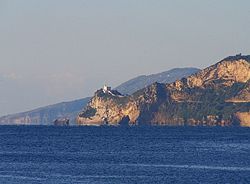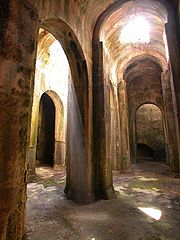
Portus Julius
Encyclopedia

Portus Julius was the home port for the Roman western imperial fleet, the classis Misenensis, named for nearby Cape Miseno
Cape Miseno
Cape Miseno is the headland that marks the northwestern limit of the Gulf of Naples as well as the Bay of Pozzuoli in southern Italy...
. (The eastern fleet was in the Port of Ravenna
Port of Ravenna
The Port of Ravenna, is an Italian seaport on the North Adriatic Sea in Ravenna, ItalyThe coordinates for this canal port are 44° 29’ N and 12° 17’ Efor Marina di Ravenna sideWP2 44° 29’,58 N 12° 17’,48 EWP3 44° 29’,42 N 12° 17’,43 E...
.) The port was located at the western end of the gulf of Naples
Naples
Naples is a city in Southern Italy, situated on the country's west coast by the Gulf of Naples. Lying between two notable volcanic regions, Mount Vesuvius and the Phlegraean Fields, it is the capital of the region of Campania and of the province of Naples...
and other than the waters of the bay, itself, consisted of three bodies of water in the area: Lake Lucrino
Lucrinus Lacus
Lucrinus Lacus, or Luctrin Lake is a lake of Campania, southern Italy, about three kilometres to the south of Lake Avernus....
, Lake Averno
Avernus
Avernus was an ancient name for a crater near Cumae , Italy, in the Region of Campania west of Naples. It is approximately in circumference. Within the crater is Lake Avernus .-Role in ancient Roman society:...
, and the natural inner and outer harbor behind Cape Misenum
Cape Miseno
Cape Miseno is the headland that marks the northwestern limit of the Gulf of Naples as well as the Bay of Pozzuoli in southern Italy...
. The port was named for Augustus
Augustus
Augustus ;23 September 63 BC – 19 August AD 14) is considered the first emperor of the Roman Empire, which he ruled alone from 27 BC until his death in 14 AD.The dates of his rule are contemporary dates; Augustus lived under two calendars, the Roman Republican until 45 BC, and the Julian...
.
Construction
To counter the frequent raids on Italy and upon the shipping routes for Rome's grain supply conducted by Sextus PompeiusSextus Pompeius
Sextus Pompeius Magnus Pius, in English Sextus Pompey , was a Roman general from the late Republic . He was the last focus of opposition to the Second Triumvirate...
(the younger son of Pompey the Great), Marcus Agrippa constructed a safe naval harbour from which to conduct a naval campaign against Sextus. It was constructed from 37-36BC and named Portus Iulius in honour of Agrippa's friend and patron Octavian (later Augustus). Shortly after the successful conclusion of the war with Sextus it was abandoned, owing to the piling up of silt compromising its navigability. Nearby Misenum became the naval base for the Western Mediterranean.

Aqueduct
The Romans built new breakwaters and a freshwater reservoir, the Piscina MirabilisPiscina Mirabilis
The Piscina Mirabilis was a freshwater cistern on the Bacoli cliff at the western end of the Gulf of Naples, southern Italy. One of the largest freshwater cisterns built by the ancient Romans, it was situated there in order to provide the Roman western imperial fleet at Portus Julius with drinking...
, of unparalleled size. It was fed by the Aqua Augusta (Naples), an aqueduct
Aqueduct
An aqueduct is a water supply or navigable channel constructed to convey water. In modern engineering, the term is used for any system of pipes, ditches, canals, tunnels, and other structures used for this purpose....
which also supplied Pompeii
Pompeii
The city of Pompeii is a partially buried Roman town-city near modern Naples in the Italian region of Campania, in the territory of the comune of Pompei. Along with Herculaneum, Pompeii was destroyed and completely buried during a long catastrophic eruption of the volcano Mount Vesuvius spanning...
.
The outer harbor behind Cape Misenum served the active vessels of the Roman navy and provided room for training exercises, while its inner counterpart (to which it was connected by a canal crossed by a wooden bridge) was designed for the reserve fleet and for repairs, and as a refuge from storms. Because of its location, the area controlled the entire Italian west coast, the islands and the Straits of Messina.
Present state

Monte Nuovo
Monte Nuovo is a cinder cone volcano within the Campi Flegrei caldera, near Naples, southern Italy. A series of damaging earthquakes and changes in land elevation preceded its only eruption, which lasted from September 29 to October 6, 1538, when it was formed...
" (New Mountain). Shifting coastlines over the centuries have also put a number of the original harbour facilities under water; some of them may be seen from glass-bottom boats or by scuba-diving.

